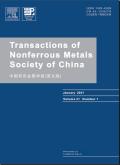Microstructure evolution and mechanical properties of Mg−Gd−Zn alloy with and without LPSO phase processed by multi-directional forging
IF 4.7
1区 材料科学
Q1 METALLURGY & METALLURGICAL ENGINEERING
Transactions of Nonferrous Metals Society of China
Pub Date : 2025-04-01
DOI:10.1016/S1003-6326(24)66735-X
引用次数: 0
Abstract
The homogenized Mg−5.6Gd−0.8Zn (wt.%) alloys were treated with water cooling and furnace cooling to obtain specimens without and with the 14H long-period stacking ordered (LPSO) phase. Subsequently, multi-directional forging (MDF) experiments were carried out. The microstructure and mechanical properties of different regions (the center, middle and edge regions) in the MDFed alloys were systematically investigated, and the effect of LPSO phase on them was discussed. The results show that the alloys in different regions undergo significant grain refinement during the MDF process. Inhomogeneous microstructures with different degrees of dynamic recrystallization (DRX) are formed, resulting in microhardness heterogeneity. The alloy with the LPSO phase has higher microstructure homogeneity, a higher degree of recrystallization, and better comprehensive mechanical properties than the alloy without the LPSO phase. The furnace-cooled alloy after 18 passes of MDF has the best comprehensive mechanical properties, with an ultimate compressive strength of 488 MPa, yield strength of 258 MPa, and fracture strain of 21.2%. DRX behavior is closely related to the LPSO phase and deformation temperature. The kinked LPSO phase can act as a potential nucleation site for DRX grains, while the fragmented LPSO phase promotes DRX nucleation through the particle-stimulated nucleation mechanism.
多向锻造含与不含LPSO相Mg - Gd - Zn合金的组织演变及力学性能
对Mg−5.6Gd−0.8Zn (wt.%)合金进行水冷却和炉冷处理,得到无14H长周期有序堆积相(LPSO)和有14H长周期有序堆积相(LPSO)的试样。随后进行了多向锻造(MDF)试验。系统地研究了MDFed合金中不同区域(中心、中间和边缘区域)的组织和力学性能,并讨论了LPSO相对它们的影响。结果表明,不同区域的合金在MDF过程中均发生了明显的晶粒细化。形成不同程度动态再结晶(DRX)的不均匀组织,导致显微硬度不均匀。与不含LPSO相的合金相比,含LPSO相的合金组织均匀性更高,再结晶程度更高,综合力学性能更好。MDF经18道次炉冷合金的综合力学性能最好,抗压强度为488 MPa,屈服强度为258 MPa,断裂应变为21.2%。DRX行为与LPSO相和变形温度密切相关。弯曲的LPSO相可以作为DRX晶粒的潜在成核位点,而破碎的LPSO相通过粒子刺激成核机制促进DRX成核。
本文章由计算机程序翻译,如有差异,请以英文原文为准。
求助全文
约1分钟内获得全文
求助全文
来源期刊
CiteScore
7.40
自引率
17.80%
发文量
8456
审稿时长
3.6 months
期刊介绍:
The Transactions of Nonferrous Metals Society of China (Trans. Nonferrous Met. Soc. China), founded in 1991 and sponsored by The Nonferrous Metals Society of China, is published monthly now and mainly contains reports of original research which reflect the new progresses in the field of nonferrous metals science and technology, including mineral processing, extraction metallurgy, metallic materials and heat treatments, metal working, physical metallurgy, powder metallurgy, with the emphasis on fundamental science. It is the unique preeminent publication in English for scientists, engineers, under/post-graduates on the field of nonferrous metals industry. This journal is covered by many famous abstract/index systems and databases such as SCI Expanded, Ei Compendex Plus, INSPEC, CA, METADEX, AJ and JICST.

 求助内容:
求助内容: 应助结果提醒方式:
应助结果提醒方式:


